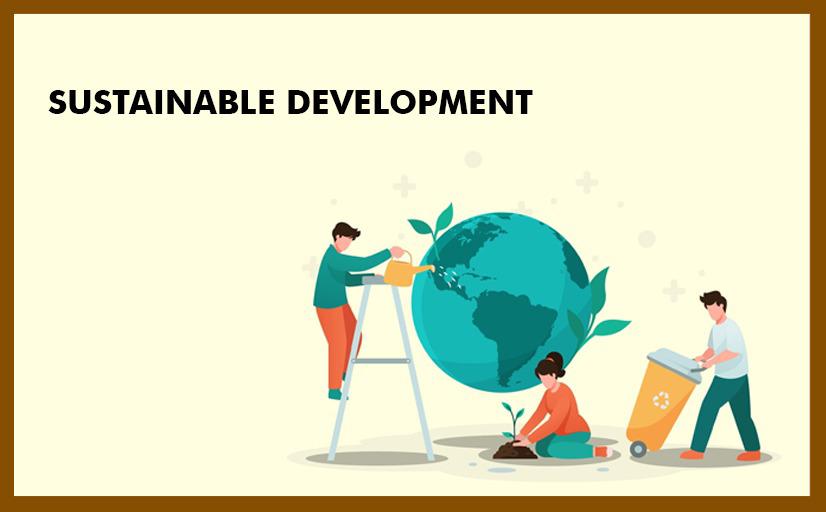
Sustainable development
A strategy for a nation's economic growth without compromising the environment's quality for future generations is known as sustainable development.
Sustainable development

A strategy for a nation's economic growth without compromising the environment's quality for future generations is known as sustainable development. Land degradation, soil erosion, air and water pollution, deforestation, and other forms of environmental harm are paid for in the name of economic development. The negative effects might outweigh the benefits of producing goods and services of higher quality.
Sustainable Development Goals
- To support development that reduces environmental issues.
- Satiate the needs of the current generation without sacrificing the environment's quality for the benefit of future generations.
Achieving Sustainable Development
Sustainable development can be achieved if we follow the following points:
- Limiting human activity is one way to achieve it.
- Technology should be developed with effective input, not with ineffective input.
- Consumption should not occur at a faster rate than salvation.
- Consumption rates for renewable resources shouldn't be higher than those for their renewable alternatives.
- Pollution of all kinds ought to be minimized.
- By using natural resources wisely, it can be accomplished.
Examples of Sustainable Development tools
- Crop rotation
- Sustainable construction
- Efficient water fixtures
- Sustainable forestry
- Wind energy
- Solar energy
- Green space
Importance of Sustainable Development
- Sustainable Development is a term used to refer to the idea of environmentally friendly economic growth.
- Achieving a balance between environmental, economic, and sociopolitical sustainability is the aim of this.
- By gradually altering the ways we create and use technologies, sustainable development constantly motivates us to protect and improve our natural resources.
- Every nation should be able to meet its basic requirements for employment, food, energy, water, and sanitization.
- Reducing pollution, poverty, and unemployment is a simple way to ensure that everyone has the right to a healthy, safe, and clean environment.
What do we need to know about the environmental crisis?
When the environment is unable to provide for human life, it is said to be in an environmental crisis. When the following occurs, the environment is suitable:
- Resources are being extracted at a slower rate than they are being created.
- The environment can continue to absorb the waste that is produced.
Reasons for Environmental Crisis
(1) Population explosion
- The environment is negatively impacted by rapid population growth.
- Since there is a limited supply of environmental resources, demand for them rises.
- Overuse and waste of resources are the results of this.
(2) Rise in economic activity
- Economic growth leads to wealthy production and consumption of goods and services.
- Overflowing the environment's ability to absorb them, it produces waste.
(3) Rapid Industrialisation
- Deforestation and resource depletion are results of rapid industrialization.
- Due to the growing buildup of hazardous materials and industrial waste in the water bodies, it causes water contamination.
(4) Urbanisation
- Slum areas quickly expand as a result of a significant population shift from rural to urban areas.
- It causes the current infrastructural activities to be overburdened.
(5) Deforestation
- Cutting down trees and clearing forests are examples of deforestation.
- In addition to other issues, it has a negative impact on the environment.
(6) Increased use of insecticides, pesticides, and chemical fertilizers
- Due to the increased use of toxic insecticides, pesticides, and chemical fertilizers, farmers and workers experience health issues.
- Chemical components are included in the crop that is produced as well.
Positive Effects of Sustainable Development
- Energy-saving: Due to the type of site where its infrastructure is located, they are built to capture as much sunlight as possible while favoring ventilation in all of its corners.
- Health Care: Some environmentally friendly homes include green areas, spas, and even gyms that promote daily exercise and support each individual's health.
- Environmentally friendly: The conceptual framework for economic growth without endangering the environment, as well as the fundamental support structure upon which everything else is based. It has an immediate impact on the search for alternative, clean, and equally effective forms of energy because it involves lowering the emissions of gases that contribute to problems like acid rain or global warming.
Because human activities are responsible for a sizable portion of environmental degradation, adopting this philosophy necessitates taking steps to reduce pollution. The benefits of doing so include improved air quality, more green space, the preservation of the biodiversity of the planet, the survival of more species, etc.
- Water conservation: Water-saving valves, a rainwater collection system, and grey water treatment—which is used for bathroom drainage and irrigation—are all features of the environmentally friendly apartments.
Negative aspects of sustainable development
- Costs: It is expensive to implement them because doing so requires changing consumption patterns, upgrading infrastructure, and replacing an energy source that currently only serves a portion of the population.
- Unemployment in some areas: Diverse industries may be forced to scale back their operations or, in the worst case, completely cease operations as a result of changes to conserve and protect ecosystems and biodiversity. This may lead to unemployment for many people who have spent their entire working lives in a single industry, like the coal industry.
- More requirements:Companies, factories, plants, and other entities that have an impact on the environment would be held to higher standards, including reducing carbon dioxide emissions and discarding trash properly.
- Fragile commitment: There is a chance that the promise made to society won't be taken as seriously because the transition to a more environmentally friendly industry is more expensive and more difficult to achieve due to the factors discussed above.
